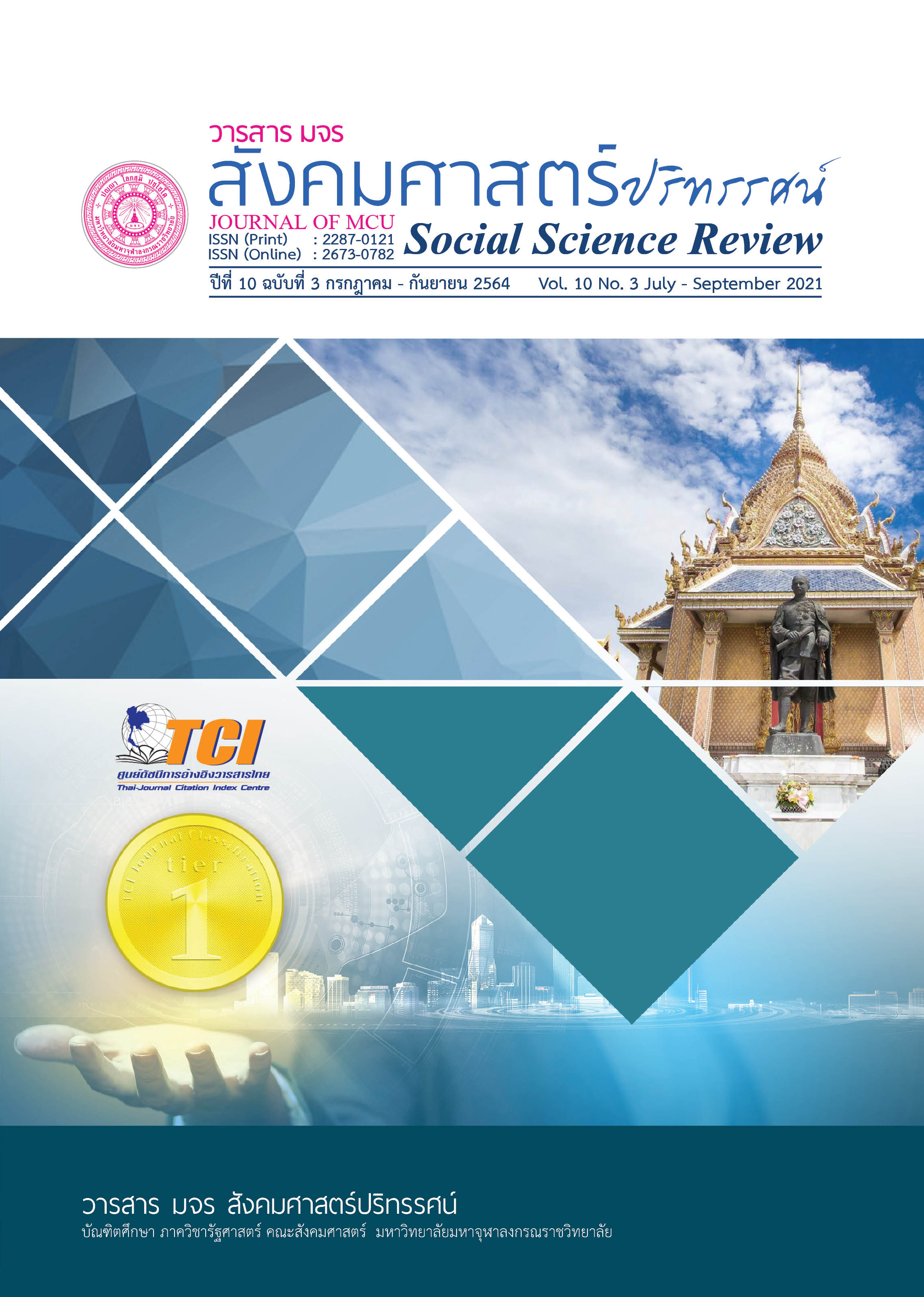โมเดลความสัมพันธ์เชิงสาเหตุของการเรียนออนไลน์ต่ออาการปวดหลังส่วนล่างของนักเรียนชั้นมัธยมศึกษา
คำสำคัญ:
การเรียนออนไลน์, อาการปวดหลังส่วนล่าง, นักเรียนมัธยมศึกษาบทคัดย่อ
บทความวิจัยนี้มีวัตถุประสงค์เพื่อ 1) พัฒนาและตรวจสอบความสอดคล้องของโมเดลความสัมพันธ์เชิงสาเหตุของการเรียนออนไลน์ต่ออาการปวดหลังส่วนล่างของนักเรียนมัธยมศึกษากับข้อมูลเชิงประจักษ์ และ 2) เพื่อวิเคราะห์อิทธิพลของการเรียนออนไลน์ต่ออาการปวดหลังส่วนล่างของนักเรียนมัธยมศึกษา ดำเนินการเก็บข้อมูลจากกลุ่มตัวอย่างนักเรียนมัธยมศึกษาชั้นปีที่ 1 ถึงปีที่ 6 โรงเรียนราชวินิต มัธยม จำนวนทั้งสิ้น 1,124 คน ด้วยแบบสอบถามออนไลน์
ผลการวิจัยพบว่าโมเดลความสัมพันธ์เชิงสาเหตุที่พัฒนาขึ้นสอดคล้องกับข้อมูลเชิงประจักษ์ (2 = 97.219, df = 84, P = .153,
2/df = 1.157, GFI = .990, AGFI = .981, RMSEA = .012) โดยอิริยาบถเป็นปัจจัยที่มีอิทธิพลทางตรงเป็นลบต่ออาการปวดหลังส่วนล่างของนักเรียนมากที่สุด รองลงมาคืออุปกรณ์เทคโนโลยี ในขณะที่เฟอร์นิเจอร์ไม่มีอิทธิพลทางตรงต่ออาการปวดหลังส่วนล่างของนักเรียน และพบว่าทั้งอุปกรณ์เทคโนโลยีและเฟอร์นิเจอร์มีอิทธิพลทางตรงต่ออิริยาบถและมีอิทธิพลทางอ้อมเป็นลบต่ออาการปวดหลังส่วนล่างของนักเรียน
เอกสารอ้างอิง
สำนักงานกองทุนสนับสนุนการสร้างเสริมสุขภาพ. (2561a). พฤติกรรม 5 อย่าง ไม่ควรทำในสำนักงาน. สืบค้น 3 เมษายน 2564, จาก https://www.thaihealth.or.th/Content/41518-%E0%B8%9E%E0%B8%A4%E0%B8%95%E0%B8%B4%E0%B8%81%E0%B8%A3%E0%B8%A3%E0%B8%A1%20%E0%B9%95%20%E0%B8%AD%E0%B8%A2%E0%B9%88%E0%B8%B2%E0%B8%87%20%E0%B9%84%E0%B8%A1%E0%B9%88%E0%B8%84%E0%B8%A7%E0%B8%A3%E0%B8%97%E0%B8%B3%E0%B9%83%E0%B8%99%E0%B8%AA%E0%B8%B3%E0%B8%99%E0%B8%B1%E0%B8%81%E0%B8%87%E0%B8%B2%E0%B8%99.html
สำนักงานกองทุนสนับสนุนการสร้างเสริมสุขภาพ. (2561b). ปรับพฤติกรรม นั่ง นอน ทำงาน ป้องกันปวดหลัง. สืบค้น 4 เมษายน 2564, จาก https://www.thaihealth.or.th/Content/42219-%E0%B8%9B%E0%B8%A3%E0%B8%B1%E0%B8%9A%E0%B8%9E%E0%B8%A4%E0%B8%95%E0%B8%B4%E0%B8%81%E0%B8%A3%E0%B8%A3%E0%B8%A1%20%E0%B8%99%E0%B8%B1%E0%B9%88%E0%B8%87%20%E0%B8%99%E0%B8%AD%E0%B8%99%20%E0%B8%97%E0%B8%B3%E0%B8%87%E0%B8%B2%E0%B8%99%20%20%E0%B8%9B%E0%B9%89%E0%B8%AD%E0%B8%87%E0%B8%81%E0%B8%B1%E0%B8%99%E0%B8%9B%E0%B8%A7%E0%B8%94%E0%B8%AB%E0%B8%A5%E0%B8%B1%E0%B8%87.html
Adams, M. A., et al. (2012). The Biomechanics of Back Pain (3rd ed). Elsevier: Edinburgh, UK.
Ayanniyi, O., et al. (2011). Prevalence and profile of back pain in Nigerian adolescents. Medical Principles and Practice, 20, 368-373.
Bae, J. S., et al. (2012). A Comparison Study on the Change in Lumbar Lordosis When Standing, Sitting on a Chair, and Sitting on the Floor in Normal Individuals, Journal of Korean Neurosurg Society, 51(1), 20–23.
Calvo-Muñoz, I., et al. (2013). Prevalence of low back pain in children and adolescents: a meta-analysis. BMC pediatrics, 13, 14.
Caneiro, J. P., et al. (2010). The influence of different sitting postures on head/neck posture and muscle activity. Man Ther, 15, 54–60.
Casas, S., et al. (2016). Association between the sitting posture and back pain in college students. Revista de la Universidad Industrial de Santander. Salud, 48(4), 446-454.
Chou, R., et al. (2007). Diagnosis and treatment of low back pain: a joint clinical practice guideline from the American college of physicians and the American pain society. Ann Intern Med, 147, 478–491.
Ekman, A., et al. (2000). Gender differences in musculoskeletal health of computer and mouse users in the Swedish workforce. Occupational Medicine, 50(8), 608–613.
Hair, J. F., et al. (2010). Multivariate data analysis (7th ed). New Jersey: Prentice Hall.
Hwang, J., et al. (2019). Low back pain in children: a rising concern, European Spine Journal, 28, 211–213.
Kaiser, P. (2003), Self-management for acute low back pain. Retrieved April 5, 2021, from https://thrive.kaiserpermanente.org/care-near-you/northern-california/gsaa/wp-content/uploads/sites/18/2015/11/Acute-Low-Back-Pain_tcm28-195722.pdf
Kim, S. Y., & Koo, S. J. (2016). Effect of duration of smartphone use on muscle fatigue and pain caused by forward head posture in adults. Journal of Physical Therapy Science, 28, 1669-1672.
Kristjansdottir, G., & Rhee, H. (2002), Risk factors of back pain frequency in schoolchildren: a search for explanations to a public health problem. Acta Paediatrica, 91, 849-854.
Kwon, Y., et al. (2018). The effect of sitting posture on the loads at cervico-thoracic and lumbosacral joints. Technol Health Care, 26, 409–418.
Lee, S., et al. (2015). Head flexion angle while using a smartphone. Ergonomics, 58(2), 220-226.
Paranjape, S., & Ingole, V. (2018). Prevalence of back pain in secondary school students in an urban population: cross-sectional study. Cureus, 10(7), e2983.
Shehab, D., & Al-jarallah, K. (2005). Nonspecific low-back pain in Kuwaiti children and adolescents: Associated factors. Journal of Adolescent Health, 36(1), 32-35.
Shirzaei, M., et al. (2015). Evaluation of ergonomic factors and postures that cause muscle pains in dentistry students’ bodies. Journal of Clinical and Experimental Dentistry, 7(3), 414–418.
Yamamoto, Y., et al. (2019). Influence of Smartphone Usage on Low Back Pain and/or Shoulder Pain in College Students in a Judo Therapist Training Course: A pilot study, Journal of Allied Health Sciences, 10(1), 1-9.
ดาวน์โหลด
เผยแพร่แล้ว
รูปแบบการอ้างอิง
ฉบับ
ประเภทบทความ
สัญญาอนุญาต
ลิขสิทธิ์ (c) 2021 วารสาร มจร สังคมศาสตร์ปริทรรศน์

อนุญาตภายใต้เงื่อนไข Creative Commons Attribution-NonCommercial-NoDerivatives 4.0 International License.
เพื่อให้เป็นไปตามกฎหมายลิขสิทธิ์ ผู้นิพนธ์ทุกท่านต้องลงลายมือชื่อในแบบฟอร์มใบมอบลิขสิทธิ์บทความให้แก่วารสารฯ พร้อมกับบทความต้นฉบับที่ได้แก้ไขครั้งสุดท้าย นอกจากนี้ ผู้นิพนธ์ทุกท่านต้องยืนยันว่าบทความต้นฉบับที่ส่งมาตีพิมพ์นั้น ได้ส่งมาตีพิมพ์เฉพาะในวารสาร มจร สังคมศาสตร์ปริทรรศน์ เพียงแห่งเดียวเท่านั้น หากมีการใช้ภาพหรือตารางหรือเนื้อหาอื่นๆ ของผู้นิพนธ์อื่นที่ปรากฏในสิ่งตีพิมพ์อื่นมาแล้ว ผู้นิพนธ์ต้องขออนุญาตเจ้าของลิขสิทธิ์ก่อน พร้อมทั้งแสดงหนังสือที่ได้รับการยินยอมต่อบรรณาธิการ ก่อนที่บทความจะได้รับการตีพิมพ์ หากไม่เป็นไปตามข้อกำหนดเบื้องต้น ทางวารสารจะถอดบทความของท่านออกโดยไม่มีข้อยกเว้นใดๆ ทั้งสิ้น





